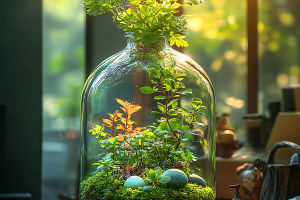The world's climates vary widely, from scorching deserts to freezing tundras, each presenting its unique set of challenges for life to thrive.
Among the many organisms that have learned to survive in these extreme conditions, plants stand out for their remarkable ability to adapt.
Whether in the dry heat of a desert or the icy chill of a polar region, plants have evolved a variety of mechanisms to help them cope with harsh climates. But how exactly do they do it?
Plants are incredibly diverse, and each species has evolved specialized adaptations to survive in its specific climate. These adaptations allow plants to regulate their internal processes, manage water usage, conserve energy, and protect themselves from extreme temperatures. Let's explore how plants adapt to different climates and how these adaptations contribute to their survival.
Desert Adaptations: Surviving Extreme Heat
Deserts are known for their extreme heat and lack of water, making them one of the most challenging climates for plant survival. Despite these conditions, many plant species thrive in arid regions, thanks to their specialized adaptations.
1. Water Storage: Cacti and other desert plants store water in their thick, fleshy stems. This allows them to survive long periods without rain. The ability to store water helps them endure the dry seasons when water is scarce.
2. Waxy Coating: Many desert plants have a waxy coating on their leaves or stems that helps reduce water loss. This waxy cuticle acts as a barrier to evaporation, ensuring that the plant retains as much water as possible.
3. Reduced Leaf Surface Area: Some desert plants, such as cacti, have very small or no leaves at all. This reduces the surface area through which water can evaporate. In the case of cacti, the stems take over the photosynthesis process, further reducing the need for leaves.
4. Deep Root Systems: To access underground water reserves, desert plants often develop deep and extensive root systems. These roots can reach water sources deep below the surface, enabling the plants to survive even in drought conditions.
Tropical Adaptations: Thriving in Humidity
Tropical climates are characterized by high temperatures and heavy rainfall throughout the year. While these conditions may seem ideal for plant growth, they also present challenges such as competition for sunlight and the risk of fungal infections due to constant moisture. Here's how plants thrive in the tropics:
1. Large Leaves: Tropical plants often have large, broad leaves to maximize their ability to capture sunlight. These large leaves also help in the process of transpiration, where excess water vapor is released into the atmosphere, helping to regulate internal moisture.
2. Drip Tips: Many tropical plants have specialized leaf shapes with pointed tips that allow excess water to drip off quickly. This helps prevent water from accumulating on the leaves and potentially fostering the growth of harmful fungi or mold.
3. Epiphytic Growth: Some plants, like orchids and bromeliads, grow on other plants without harming them. These epiphytes, known as "air plants," have adapted to living high in the tree canopy where they receive ample sunlight and access to moisture from rainfall and humidity.
4. Symbiotic Relationships: In the dense tropical rainforest, plants often engage in symbiotic relationships with other organisms. For example, some plants form mutualistic relationships with ants, where the ants protect the plant from herbivores, and in return, they get access to the plant's nectar.
Arctic and Alpine Adaptations: Surviving the Cold
In contrast to the heat of deserts and the humidity of tropical climates, the cold and often frozen tundras and mountain regions present unique challenges to plant life. In these extreme environments, plants face freezing temperatures, short growing seasons, and limited sunlight. But many have developed specialized strategies for survival:
1. Low Growing Habit: Many plants in cold climates grow close to the ground. This low growing habit helps protect them from strong winds and allows them to take advantage of the heat stored in the ground during the day. Being near the surface also helps them avoid the worst of the cold air temperatures.
2. Antifreeze Compounds: Some plants produce antifreeze proteins that prevent ice from forming within their cells. This is crucial for surviving in environments where the temperature regularly drops below freezing.
3. Small, Tough Leaves: Cold-climate plants often have small, leathery leaves that help minimize water loss. The tough texture of the leaves also prevents damage from freezing and thawing cycles that could harm more delicate tissues.
4. Seasonal Growth Cycles: In the Arctic and alpine regions, plants often have short growing seasons, so they have adapted to grow rapidly during the brief periods of warmth. These plants are often perennials, growing back each year, and they have evolved to store energy in their roots and underground parts to survive the harsh winters.
Temperate Adaptations: Thriving in Moderate Conditions
Temperate climates, characterized by moderate temperatures and seasonal changes, offer a more balanced environment for plant growth. Plants in these regions are subject to seasonal variations, such as cold winters and warm summers, and must adapt to these changes to survive. Here's how temperate plants thrive:
1. Dormancy: Many plants in temperate regions go dormant during the winter months to survive the cold. Trees such as oaks and maples shed their leaves and enter a state of dormancy, conserving energy until the warmer spring months return.
2. Deciduous Leaves: In temperate climates, deciduous trees shed their leaves in the fall, a strategy that helps them conserve water and energy during the winter. By losing their leaves, these trees reduce the surface area through which water can evaporate, preventing dehydration during cold and dry months.
3. Insulating Snow Cover: In areas where snow is common, the snow can act as an insulating layer, protecting the soil and plant roots from freezing. Plants that grow in these areas are adapted to withstand occasional frosts, and the snow helps regulate the temperature around the plant.
4. Flexible Growth: Plants in temperate climates are adaptable, with the ability to thrive in both spring and summer conditions. They can grow and flower when the weather is mild, and their flexibility allows them to survive variable weather patterns that come with seasonal changes.
Conclusion: The Wonder of Plant Adaptation
Plants are truly remarkable in their ability to adapt to the challenges of different climates. From the scorching deserts to the freezing arctic tundra, plants have evolved diverse and ingenious strategies to survive and thrive. Understanding how plants adapt to their environment not only fascinates us but also helps us in gardening, agriculture, and conservation efforts.
So, the next time you see a plant thriving in an environment that seems inhospitable, take a moment to appreciate the amazing adaptations that have enabled it to survive. Do you have any favorite plant adaptations that you've encountered? Share your thoughts with us in the comments below!


